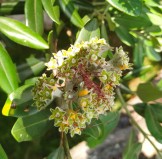Myrtle rust on iNaturalist: observations on the increase
Between 1 November 2021 and 10 June 2022, New Zealanders reported 827 new observations of myrtle rust. This is much more than the number of observations reported last year during the same window (561 observations between 1 November 2020 and 10 June 2021). Observations continue to feed through to the interactive ‘Myrtle rust surveillance map’, providing valuable information on where the disease is being (and has been) seen around the country.
Most of the summer 2021-2022 reports were made in the North Island, especially on the highly susceptible ramarama (Lophomyrtus bullata), and on lilly pilly hedges around Auckland. The North Island observations revealed three particularly notable developments in the spread of myrtle rust.

Infected Metrosideros excelsa pods. Image: V Kholostiakov
- In at least 55 of these observations, the host plant is pōhutukawa. Several of these reports are of severely infected young pōhutukawa. Reports include infections reported not just on the leaves, but on the buds, seed pods and fruits as well.
- There are also many reports of myrtle rust infecting swamp maire (Syzygium maire). These observations match what is being seen in the field by researchers and community groups—swamp maire appear to be hit harder by myrtle rust with each passing season, with the disease being seen in urban as well as in more remote areas.
- Myrtle rust is increasingly being reported in the Wellington region.
On the South Island, dozens of observations were recorded in the northernmost areas, especially around the coastal areas of Golden Bay and Tasman Bay. There were individual reports of infections on garden Myrtaceae in both Christchurch and Timaru. Most of these reports suggest that plants had been infected elsewhere but displayed symptoms after arrival in these locations.
There were also a handful of reports made on the West Coast around Greymouth. This is not entirely unexpected, as infection risk prediction models have shown that coastal areas of the West Coast have favorable conditions for the disease in the summer. However, reports of myrtle rust on the West Coast remain few and far between.
Another important report was the detection of myrtle rust on the Chatham Islands, where it has been found on the invasive weed Chilean guava (Ugni molinae). You can read more about the unique circumstance of myrtle rust on the Chathams here.
If you would like to contribute your observations of myrtle rust, you can do so on the iNaturalist website. Please record the host plant if you know it. If you’re not sure how to identify Myrtaceae, check out this Myrtaceae Key.